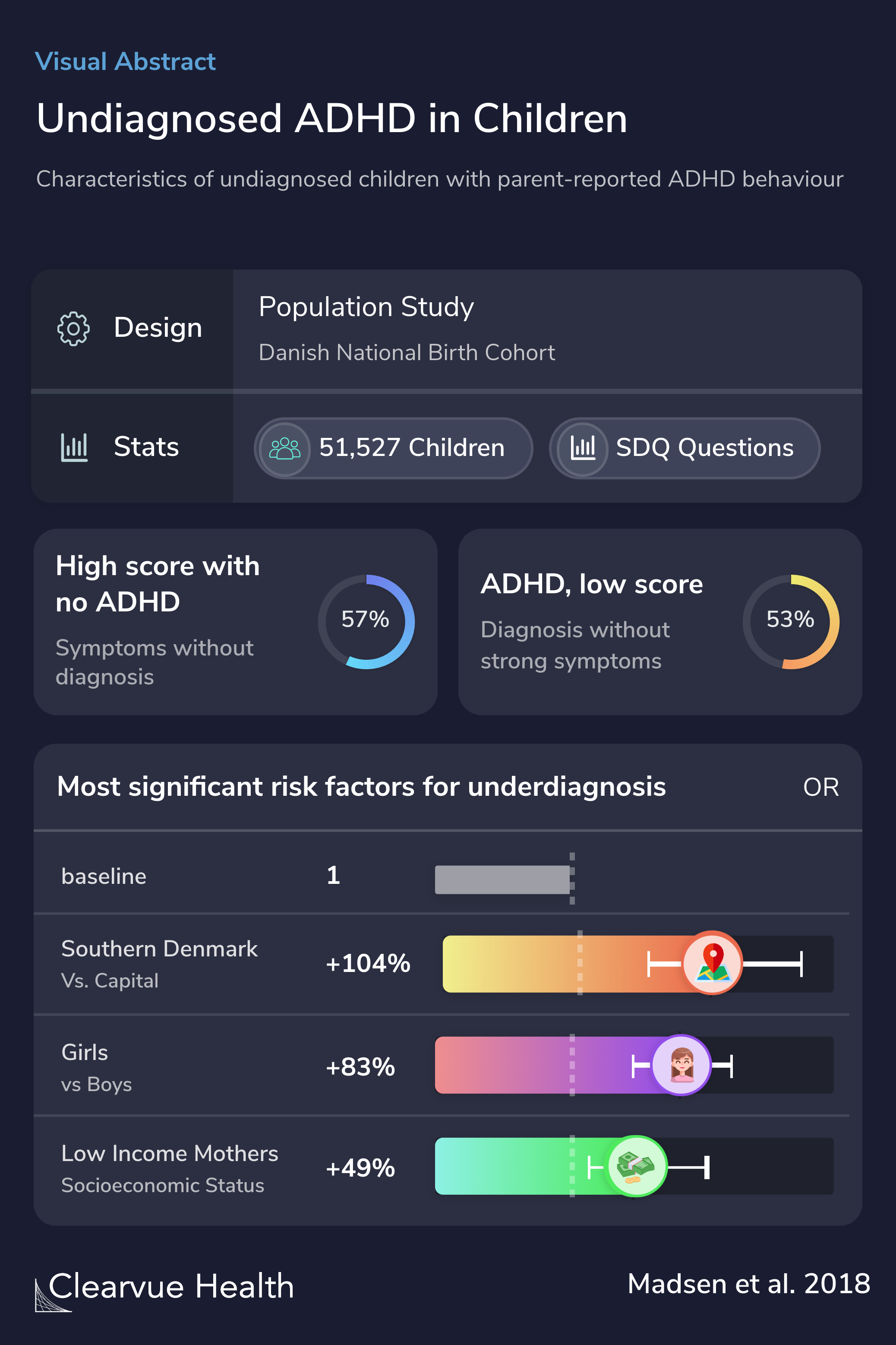Characteristics of undiagnosed children with parent-reported ADHD behaviour
Undiagnosed ADHD in Children
Kathrine Bang Madsen , Mette Holmelin Ravn , Jon Arnfred , Jørn Olsen , Charlotte Ulrikka Rask , Carsten Obel

Objectives
Many kids with ADHD go undiagnosed for one reason or another. There has not been much research before this study on ADHD underdiagnosis. This study wanted to see how often children with ADHD go undiagnosed, and what risk factors are associated with underdiagnosis.
There is an ongoing public debate on the diagnosis of attention deficit hyperactivity disorder (ADHD) in which critics have claimed that the disorder is over-diagnosed, while the potential under-diagnosis of children with ADHD has received little attention. In this study we estimate the ...
Methods
Researchers collected data from a national childbirth dataset in Denmark. They collected information on ADHD symptoms from a parent questionnaire, the SDQ.
One of the strengths of the study was that they were able to systematically gather information on ADHD diagnosis through medical records and pharmacy records.
In doing so, researchers can cross reference these records with parents' assessments of ADHD symptoms.
Our study was based on data from the Danish National Birth Cohort, where parents of 51,527 children completed questionnaires, including the Strength and Difficulties Questionnaire (SDQ). ADHD diagnosis was identified through Danish registers and parent-reported ADHD behaviour by the spec...
Results
While the ADHD symptom questionnaire was generally effective, researchers did find that many with ADHD symptoms were not diagnosed with ADHD. In contrast, many diagnosed with ADHD did not appear to have strong symptoms.
There was a significant relationship between geography and ADHD diagnosis. Children with ADHD in the southern region of Denmark were more than twice as likely to go undiagnosed than those in the capital of Denmark.
One potential explanation is that doctors in certain regions and hospitals may be more reluctant to diagnose ADHD.
While there are standardized tests for ADHD, the diagnostic process can still be quite subjective.
Gender and socioeconomic status also played a role. Girls were more than twice as likely to go undiagnosed as boys.
Children with mothers of low socioeconomic status were around 50% less likely to get diagnosed.
Many with ADHD symptoms who did not have an official ADHD diagnosis had other conditions.
Children with parent-reported ADHD behaviour and no diagnosis (1.3%) were more likely to be girls (OR 1.83; 95% CI 1.45; 2.29), more likely to have mothers with a low socioeconomic status (OR high vs. low 1.49; 95% CI 1.10; 2.02), and to live in certain regions of the country (OR: Capita...
Conclusions
These results show that certain groups of children are less likely to get diagnosed with ADHD.
The gender difference is striking and suggests a systematic underdiagnosis of girls with ADHD. A potential explanation suggested by the authors is that girls with ADHD may be less disruptive than boys with ADHD, leading to a lower likelihood of getting diagnosed:
Studies like these help identify biases and stereotypes that can get in the way of accurate diagnosis and treatment for those who need it.
The results demonstrate a considerable number of children with ADHD symptoms who potentially go undetected and underline the influence of socio-demographic factors in the pathway to a diagnosis of ADHD.